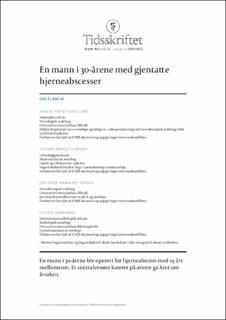| dc.contributor.author | Lier, Helene Engstrand | |
| dc.contributor.author | Brede, Vegard Rødseth | |
| dc.contributor.author | Ramm-Pettersen, Jon-Terje | |
| dc.contributor.author | Gjønnæss, Eyvind | |
| dc.coverage.spatial | Norway | en_US |
| dc.date.accessioned | 2023-05-10T09:38:02Z | |
| dc.date.available | 2023-05-10T09:38:02Z | |
| dc.date.created | 2023-01-10T14:38:01Z | |
| dc.date.issued | 2022 | |
| dc.identifier.citation | Tidsskrift for Den norske legeforening. 2022, 142 (18), . | en_US |
| dc.identifier.issn | 0029-2001 | |
| dc.identifier.uri | https://hdl.handle.net/11250/3067454 | |
| dc.description.abstract | Background: Brain abscess is a life-threatening condition. Congenital cardiovascular malformations can create right-to-left shunting and be an underlying cause.
Case presentation: A young man was admitted due to headache and deteriorating general condition. He had a history of a surgically treated brain abscess 19 years earlier. Investigations now showed a new brain abscess. The patient was operated and received a peripherally inserted central catheter in his left arm for antibiotic treatment. A chest X-ray showed abnormal positioning of the catheter lying in a persistent left superior vena cava. One day later he experienced headache and photophobia. MRI showed reoccurrence of the brain abscess and he was reoperated. Persistent left superior vena cava was considered to be the cause of the brain abscesses and he underwent endovascular embolisation and placement of a vascular plug in his left superior vena cava.
Interpretation: The oxygen-rich pulmonary circulation and its immune system make it difficult for anaerobic bacteria to pass to the arterial side. In most cases persistent left superior vena cava drains into the right atrium and is asymptomatic. In 10 % of patients the persistent left superior vena cava drains directly to the left atrium and gives a right-to-left shunt. This may cause arterial bacteraemia and brain abscesses. | en_US |
| dc.language.iso | nob | en_US |
| dc.publisher | Norwegian Medical Association | en_US |
| dc.relation.uri | https://tidsskriftet.no/2022/12/noe-laere-av/en-mann-i-30-arene-med-gjentatte-hjerneabscesser | |
| dc.rights | Attribution-NoDerivatives 4.0 Internasjonal | * |
| dc.rights | Attribution-NoDerivatives 4.0 Internasjonal | * |
| dc.rights.uri | http://creativecommons.org/licenses/by-nd/4.0/deed.no | * |
| dc.subject | Brain Abscess* / diagnostic imaging; | en_US |
| dc.subject | Brain Abscess* / etiology; | en_US |
| dc.subject | Brain Abscess* / surgery; | en_US |
| dc.subject | Headache; | en_US |
| dc.subject | Humans; | en_US |
| dc.subject | Magnetic Resonance Imaging; | en_US |
| dc.subject | Male; | en_US |
| dc.subject | Persistent Left Superior Vena Cava*; | en_US |
| dc.subject | Vena Cava, Superior / diagnostic imaging; | en_US |
| dc.title | En mann i 30-årene med gjenta hjerneabscesser | nob |
| dc.title.alternative | En mann i 30-årene med gjenta hjerneabscesser | en_US |
| dc.type | Professional article | en_US |
| dc.type | | en_US |
| dc.description.version | publishedVersion | en_US |
| dc.rights.holder | © Tidsskrift for Den norske legeforening. Publisert under åpen tilgang CC BY-ND. | en_US |
| dc.source.pagenumber | 10 | en_US |
| dc.source.volume | 142 | en_US |
| dc.source.journal | Tidsskrift for Den norske legeforening | en_US |
| dc.source.issue | 18 | en_US |
| dc.identifier.doi | 10.4045/tidsskr.21.0811 | |
| dc.identifier.cristin | 2104276 | |
| cristin.ispublished | true | |
| cristin.fulltext | original | |
| cristin.qualitycode | 1 | |

